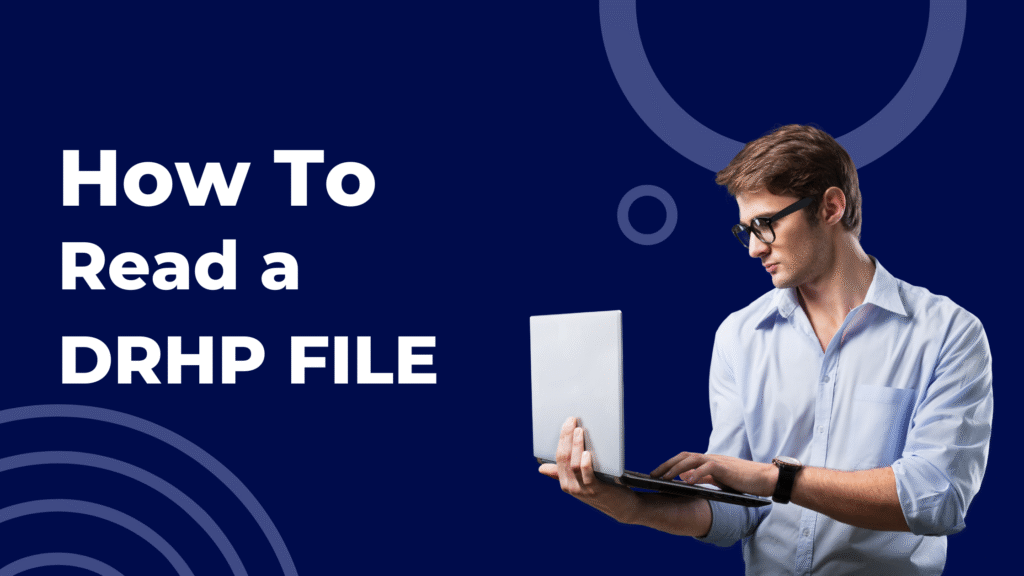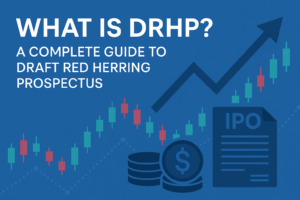How to Read a DRHP: Key Sections Every Investor Should Know
Introduction
Every Initial Public Offering (IPO) journey in India starts with a crucial document called the Draft Red Herring Prospectus (DRHP). It’s the foundation on which investors base their decisions. Yet, for most retail investors, understanding how to read a DRHP remains a mystery—full of legal language, financial data, and unfamiliar terminology.
This guide breaks down how to read a DRHP in India step-by-step, and highlighting the most important sections and what insights investors can draw to make smarter IPO investment decisions.
🧐 What Is a DRHP?
The Draft Red Herring Prospectus (DRHP) is a preliminary filing that a company submits to SEBI (Securities and Exchange Board of India) when it plans to raise funds through an IPO.
It includes detailed information about:
- The company’s business operations
- Financial performance
- Risks involved
- Objectives of the IPO
- Promoter and shareholder details
Importantly, the DRHP does not include the exact issue price of the IPO—hence the term “Red Herring.”
Once SEBI reviews and approves the DRHP, it becomes the Red Herring Prospectus (RHP), which includes final pricing and other specifics.
🔍 Where to Find the DRHP
You can access the DRHP of any upcoming IPO from:
- SEBI’s official website
- Stock exchange websites (NSE, BSE)
- Merchant banker websites (e.g., Axis Capital, ICICI Securities)
- IPO tracking platforms like Chittorgarh, IPO Central, or MoneyControl

📘 How to Read a DRHP – Key Sections Explained
Reading a 300+ page DRHP can feel overwhelming. But not all sections are equally important for investors. Here’s how to focus:
1. Cover Page & Definitions
- What It Contains: Basic information about the issue size, company name, lead managers, and disclaimer.
- Why It Matters: You get a snapshot of whether it’s a fresh issue or offer for sale (OFS) and who is managing the IPO.
⚠️ Note: In an OFS, existing shareholders are selling their shares—proceeds don’t go to the company.
2. Risk Factors (High Priority)
- Location in DRHP: Typically right after the index, spans several pages.
- What It Covers: All potential business, regulatory, legal, financial, and operational risks.
✅ What to Look For:
- Dependency on key clients or suppliers
- Ongoing or pending litigations
- High promoter pledging
- Exposure to currency fluctuations, regulatory changes
- COVID-19 related risks (for recent DRHPs)
Investor Insight: A transparent DRHP discusses risk openly. Watch out for vague language or omission of known risks.
3. Use of IPO Proceeds
- What It Covers: How the company plans to utilize the funds raised via IPO.
🔍 Examples of use:
- Repaying debt
- Funding capex or expansion
- General corporate purposes
- Acquisitions or working capital
Investor Insight: Check if the company is clearing debt or investing in growth. Avoid companies raising funds for vague “general corporate purposes” with no clarity.
4. Industry Overview
- What It Covers: Market size, growth potential, sector dynamics, trends, and government policies.
Investor Insight: Helps you understand the TAM (Total Addressable Market) and where the company stands in the industry.
💡 Tip: Compare this data with independent research to verify its accuracy.
5. Company Overview & Business Model
- What It Covers: Company history, operations, services/products, manufacturing locations, customer base, etc.
✅ Key things to note:
- Core business strengths
- Geographic presence
- Revenue-generating segments
- Business scalability
Investor Insight: Understand how the company earns money. Is it diversified or overly reliant on one revenue stream?
6. Management Discussion & Promoter Profile
- What It Covers: Key managerial personnel, promoter group background, their shareholding, and corporate governance standards.
🧠 What to check:
- Promoter experience and background
- Any criminal or regulatory history
- Promoter shareholding post-IPO
Investor Insight: A strong, ethical, and experienced promoter team inspires confidence.
7. Financial Information (Critical Section)
- Includes:
- Income statement
- Balance sheet
- Cash flow statement
- Key financial ratios
- Auditor’s notes
📈 Key Metrics to Analyze:
- Revenue growth over 3 years
- EBITDA and PAT margins
- Return on Net Worth (RoNW)
- Earnings Per Share (EPS)
- Debt-to-equity ratio
- Cash flow trends
Investor Insight: Look for consistent growth, improving margins, and strong RoNW. Negative cash flow or high debt is a red flag.
8. Outstanding Litigations and Legal Proceedings
- What It Covers: Ongoing cases involving the company, directors, or promoters.
Investor Insight: Pending legal issues can impact future performance and public image. Scrutinize this section carefully.
9. Capital Structure and Shareholding Pattern
- What It Shows:
- Pre-IPO and post-IPO shareholding
- Shareholding of promoters, institutional investors, and employees
Investor Insight: Post-IPO, promoters should still have significant skin in the game (>50%). Excessive dilution may not be ideal.
10. Offer Details & Book Building Process
- What It Includes:
- Issue size breakdown (QIB, NII, Retail)
- Bid lot, face value
- Tentative timelines
- Lead managers and registrar details
📌 Bonus Tip: Also look for any reservations for employees or existing shareholders.
11. Objects of the Offer
- Often overlaps with “Use of Proceeds,” but explained in more detail.
- Focus on why the IPO is being brought to the market, not just how the funds will be used.
🛑 Red Flags to Watch in a DRHP
- Poor or inconsistent financials
- High dependence on few clients or geographies
- Negative operating cash flow
- Large % of offer is Offer for Sale (OFS)
- Promoters reducing stake drastically
- Unexplained risk factors or vague use of funds
✅ Checklist for First-Time Investors Reading a DRHP
| Section | What to Look For |
|---|---|
| Risk Factors | Transparency, Specific Risks |
| Financials | Revenue & Profit Growth, Margins |
| Promoter Info | Background, Integrity, Post-IPO Stake |
| Business Model | Clarity, Scalability, Revenue Sources |
| IPO Proceeds | Focused Utilization, Growth-Oriented Use |
| Industry Outlook | Market Growth, Competition |
📥 Bonus: Tools to Help You Read a DRHP Easily
- Tijori Finance – Simplified DRHP analysis
- Screener.in – Financial data comparison
- Chittorgarh & IPO Central – Summarized DRHP highlights
Conclusion
Learning how to read a DRHP is not just for analysts—it’s for every investor who wants to make informed, risk-adjusted decisions. While the document may seem technical, focusing on the right sections—risk factors, financials, promoter quality, and fund usage—can uncover powerful insights.
Don’t just follow the GMP hype or listing rumors. Instead, build your conviction from the source—the DRHP.
FAQs – How to Read a DRHP
Q1. Is reading a DRHP necessary for IPO investing?
Yes. It offers original, unfiltered insight into the company’s fundamentals and risk profile.
Q2. How long is a DRHP valid?
Usually, 12 months from SEBI approval, if the RHP is not filed.
Q3. Can the DRHP change later?
Yes. Once comments are received from SEBI, the final RHP includes updates.
Q4. Is the issue price in the DRHP?
No. The DRHP does not contain final pricing or exact dates.
Share this content:






Post Comment